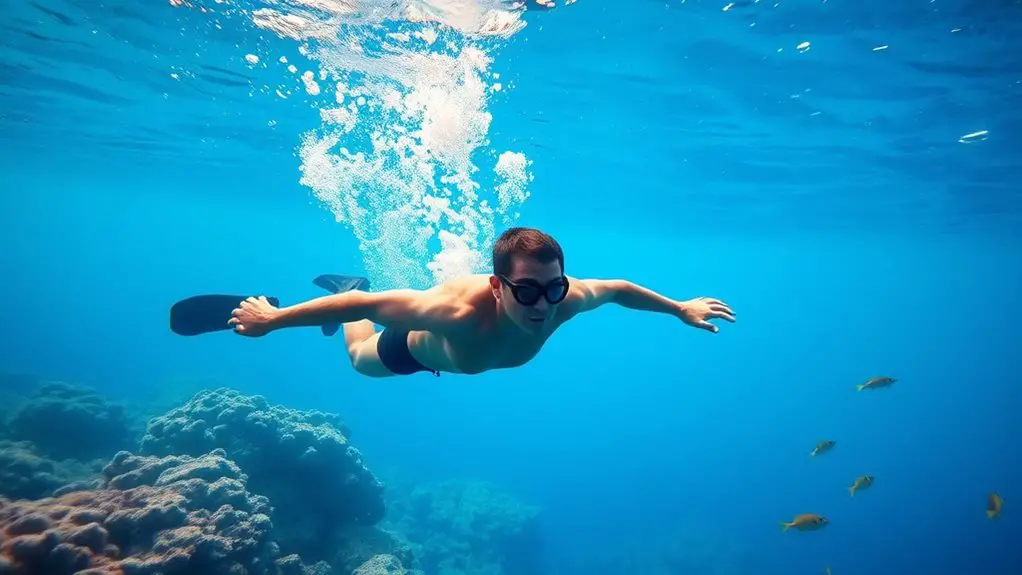Underwater training boosts your endurance by utilizing water's unique resistance and buoyancy. These properties challenge your heart and lungs, improving cardiovascular fitness while reducing joint stress. As you move through water, you'll work multiple muscle groups, enhancing overall strength and flexibility. This low-impact environment allows for effective workout sessions without traditional strain. Interested in how to make the most of your underwater training? There's plenty more to explore about its benefits and techniques.
The Science Behind Underwater Training
When you plunge into underwater training, you're not just getting wet; you're engaging in a scientifically backed method to boost your endurance. The resistance of water increases the effort required for each movement, which means your muscles work harder than they would on land. This added resistance stimulates muscle fibers, igniting growth and strength, making you feel powerful and free in your movements.
Moreover, the buoyancy of water allows you to push your limits without the same risk of injury. You can explore your capabilities while feeling weightless, enabling you to focus on form and technique. Each session becomes a dance with the elements, where you're free to challenge your body in a supportive environment.
Embracing underwater training means embracing a unique way to connect with your body, enhancing not just endurance but also a sense of freedom as you glide through the depths, discovering your true potential.
Benefits for Cardiovascular Fitness
While you might think of underwater training as primarily a strength-building exercise, it also offers remarkable benefits for your cardiovascular fitness. When you submerge yourself, the water provides resistance that challenges your heart and lungs. This unique environment encourages your body to work harder, increasing your heart rate and improving circulation. You'll find that even short sessions can elevate your stamina, allowing you to feel more energetic and free in your movements.
Moreover, the buoyancy of water reduces impact, making it easier on your joints while still pushing your cardiovascular limits. As you swim or perform underwater exercises, you'll engage multiple muscle groups, enhancing your overall endurance. This holistic approach not only builds strength but also promotes heart health and lung capacity. Additionally, proper hydration is crucial for maintaining energy levels during these workouts, ensuring you can maximize performance. So immerse yourself and explore this liberating way to boost your cardiovascular fitness, giving you more freedom in your physical pursuits!
Muscle Development Through Resistance
Building on the cardiovascular benefits, underwater training also substantially enhances muscle development through resistance. When you're submerged, the water's density works against your movements, creating a natural resistance that pushes your muscles to adapt and grow stronger. Here are three key ways it bolsters your muscle development:
- Increased Resistance: The water provides a consistent challenge, requiring your muscles to exert more effort than they would in air.
- Full-Range Motion: The buoyancy allows for a greater range of motion, engaging more muscle fibers during exercises, which can lead to enhanced strength and flexibility.
- Low Impact: Since the water cushions your movements, you can focus on building muscle without the strain that often accompanies traditional weightlifting. Additionally, incorporating squats and lunges into your underwater routine can further improve your lower body strength and coordination.
Injury Prevention and Recovery
Incorporating underwater training into your routine can markedly aid in injury prevention and recovery, as the buoyancy of water reduces stress on your joints and muscles. This unique environment allows you to push your limits without the risk of straining or overexerting yourself. You'll find that the resistance offered by water provides a gentle yet effective way to build strength while minimizing the chance of injury.
When you're submerged, movements are smoother, which can help soothe any existing aches and pains. Water's natural resistance enhances circulation, promoting faster recovery from any prior injuries. Plus, it gives you the freedom to explore various movements without the fear of impact. Additionally, engaging in underwater training can complement your recovery by allowing for active recovery techniques that support muscle repair and growth.
Ultimately, embracing underwater training can empower you to stay active and engaged, helping you maintain your endurance while prioritizing your body's safety. So plunge into it, and let the water work its magic for your injury prevention and recovery journey.
Practical Tips for Incorporating Underwater Training
After experiencing the benefits of underwater training for injury prevention and recovery, you might be wondering how to effectively integrate it into your workout routine. Here are some practical tips to help you immerse yourself:
- Start Slow: Begin with shorter sessions and gradually increase your time in the water. This'll help your body adapt to the unique resistance and buoyancy.
- Mix It Up: Combine underwater running, swimming, and plyometric exercises. This variety keeps your workouts exciting and targets different muscle groups, enhancing overall endurance.
- Set Goals: Establish clear, achievable goals for your underwater training. Whether it's distance, time, or technique, tracking progress will keep you motivated and focused.
Incorporating these tips will not only enhance your endurance but also give you the freedom to explore new dimensions of fitness. Embrace the water, and let it elevate your training experience! Additionally, underwater training can improve muscle efficiency in using oxygen, which is critical for enhancing overall body efficiency.
Frequently Asked Questions
How Often Should I Perform Underwater Training Sessions?
You should aim for underwater training sessions at least two to three times a week. Consistency's key, but listen to your body. Adjust frequency based on your goals and how you feel during each session.
What Equipment Is Necessary for Underwater Training?
You might think you don't need much for underwater training, but a mask, fins, snorkel, and buoyancy device can transform your experience. These tools let you explore and push your limits in a liberating way.
Can Beginners Participate in Underwater Training Safely?
Absolutely, you can participate in underwater training safely as a beginner! Just guarantee you're comfortable in the water, start slow, and consider working with a coach to guide you through techniques and safety practices.
How Does Underwater Training Compare to Traditional Training Methods?
Underwater training offers unique resistance and buoyancy, enhancing your workout's intensity without traditional impacts. You'll find it challenges your body differently, promoting strength and endurance in ways that regular training methods might not achieve as effectively.
Are There Age Restrictions for Underwater Training Programs?
There aren't strict age restrictions for underwater training programs. Most programs welcome participants of various ages, but it's best to check specific requirements. You'll likely find options tailored to your fitness level and goals.




